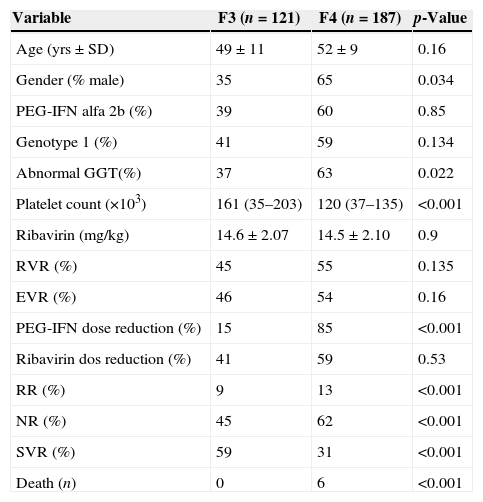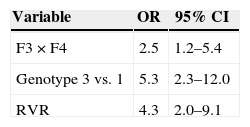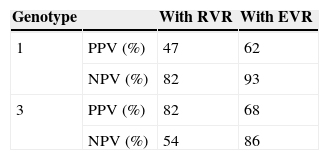Tolerance and response to antiviral HCV treatment is poor in advanced fibrosis. The aim of this study was to assess SVR rate and its predictive factors in HCV advanced fibrosis patients treated in real life with full dose PEG-IFN plus RBV and to evaluate the adverse events related to treatment.
MethodsA multicentric, retrospective study was conducted at six university hospitals. METAVIR F3 and F4 HCV monoinfected patients who were treated with PEG-IFN and RBV had their data analyzed. A stepwise logistic regression analysis was performed to identify the variables independently related to SVR. Adverse events were recorded during treatment.
Results308 patients were included, 75% genotype 1 and 23% genotype 3. METAVIR F3 was present in 39% and F4 in 61% of patients. The median Child Pugh score for F4 patients was 5 (5–9). The global SVR rate was 34%, 11% were relapsers and 55% were nonresponders. SVR rates were similar between patients treated with PEG-IFN alfa 2a or alfa 2b (p=0.24). SVR rates according to Child–Pugh score were 26% (Child A) and 18% (Child B). The independent factors related to SVR in F4 patients were genotype 3, RVR and fewer Child Pugh score points. Treatment interruption occurred in 31% patients and death occurred in 1.9%, all with liver cirrhosis.
ConclusionTreatment of HCV in patients with advanced fibrosis should not be postponed. However, a very careful evaluation of cirrhotic patients must be performed before treatment is indicated and careful monitoring is required during treatment.
Hepatitis C virus (HCV) infects more than 170 million people worldwide, and is the leading cause of hepatocellular carcinoma and liver transplantation in the western world.1 When cirrhosis is established, the risk of clinical decompensation is high. Furthermore, tolerance and response to antiviral treatment in advanced fibrosis is poor.2–4 Nevertheless, achievement of a sustained virological response (SVR) in these patients reduces the incidence of hepatic decompensation as well as the development of hepatocellular carcinoma and death.5–7 Recently, a meta-analysis showed that even if SVR is not achieved, interferon therapy could be associated with prevention of HCC development.7 Hence, HCV infection eradication in this population might be stimulated.
However, results on therapeutic efficacy trials with patients with advanced fibrosis are hetereogeneous, and many studies consist of sub-analyses from pivotal trials.8,9 Real life studies in this population are scarce. In addition, data is heterogeneous comprising different treatment schedules like alpha interferon (IFN) or alpha Pegylated interferon (PEG-IFN) either as monotherapy or associated to ribavirin (RBV).2,5,10,11 With the recent approval of the protease inhibitors for HCV treatment new adverse events will occur and this might be balanced in this specific population. However, in many countries these drugs have not yet been approved and patients with advanced fibrosis are still treated with the association of PEG-IFN and RBV. Notwithstanding, the combination of PEG-IFN and RBV will still be necessary for the treatment with the current protease inhibitors. Thus, the aim of this study was to assess the rate of SVR and its predictive factors in an HCV infected population with advanced fibrosis treated in real life conditions with full dose peginterferon alfa 2a or alfa 2b plus bodyweight-adjusted dose of ribavirin and to evaluate the adverse events related to treatment.
Patients and methodsA multicentric, retrospective study was conducted in six University Hospitals in Brazil. The Ethics Committee of the University Hospital of Botucatu School of Medicine, São Paulo, approved the study protocol. All patients’ data were codified to guarantee anonymity. At each participating center the local principal investigator identified eligible patients based on predefined criteria and data was entered on a database. The inclusion criteria were as follows: naïve HCV-RNA positive patients with bridging fibrosis (METAVIR score F3) or cirrhosis (METAVIR score F4) at liver biopsy. Patients who had clinical or ultrasonographic evidence of cirrhosis were considered as cirrhotics without liver biopsy and were also allocated as F4. Cirrhotic patients were considered as decompensated at baseline if they were presented with jaundice, ascites, esophageal varices or hepatic encephalopathy. The exclusion criteria were: HIV or HBV co-infection, hepatocellular carcinoma at baseline and Child–Pugh score higher than 9.
Patients were treated with full dose PEG-IFN alpha-2a or alpha-2b and ribavirin according to body weight. Patients with <75kg received 1000mg/d of ribavirin and those whose weight was ≥75kg were treated with 1250mg/d. Treatment was based on the criteria established by the Brazilian Ministry of Health for treatment of chronic HCV infection. Treatment would be interrupted at week 12 if less than a 2-log drop from baseline viral load was identified. In those with at least 2-log drop in viral load at week 12, a new viral load was performed at week 24 and if the HCV-RNA was detectable, treatment was stopped as well. All patients were treated for 48 weeks regardless of genotype.
Data included in the analysis were as follows: gender, age, weight at baseline, fibrosis level defined by METAVIR score, viral genotype, HCV-RNA levels at baseline and at weeks 4, 12, 24, 48 and 72, ribavirin dose (mg/kg), and platelet count. Laboratory baseline data included in the analysis were liver enzymes (ALT, AST and GGT) and liver function tests (albumin, bilirubin and INR). Child–Pugh score was registered for F4 patients. Reasons of reduction of either peginterferon or RBV and for early treatment discontinuation were also recorded. Three modalities of treatment response were defined: non-responders (detectable HCV-RNA w24 or w48 or absence of a two log reduction in the viral load at week 12), relapsers (HCV-RNA undetectable at the end of treatment but detectable 24 weeks after the end of treatment), and sustained virological response (undetectable HCV-RNA at week 24 after the end of treatment). An intent-to-treat analysis was carried out in patients receiving at least one dose of medication and those patients who did not complete the treatment regimen were classified as non-responders.
Statistical analysisData was recorded and analyzed using SPSS 17.0, Chicago, IL, USA. Nominal variables are presented in absolute and relative frequencies. For continuous variables, descriptive statistics are presented as mean and standard deviation, with minimum and maximum values. The associations between selected factors and SVR were analyzed by using the chi-square and Fisher's exact tests when indicated. A stepwise logistic regression analysis was performed in order to identify the variables independently related to SVR. Variables who presented a p-value <0.20 at the univariate analysis were included in the regression analysis. A significance level of 5% was adopted.
ResultsThree hundred and eight patients were included (62% male, mean age of 52±10 yrs, median body weight was 76±15kg). Regarding genotype, 232 (75%) patients were genotype 1 and 72 (23%) genotype 3. Two additional patients were genotype 2 (1%) and genotype was inconclusive in 2 others (1%). Patients with genotype 2 and inconclusive genotype were excluded from the analysis. Stage 3 fibrosis was present in 121 (39%) and stage 4 (cirrhosis) in 187 (61%) patients. In patients with stage 4, the median Child Pugh score was 5.5–9 Mean baseline HCV-RNA was 5.55±0.94 log. Mean platelet count at baseline was 141.735±59.649/mL.
Efficacy of treatmentThe global SVR rate was 34%, 11% were relapsers and 55% were nonresponders. SVR rates did not differ significantly between patients treated with peginterferon alfa 2a or alfa 2b (34%×32%, respectively; p=0.24). Genotype 1 patients had a higher SVR if the ribavirin dose was not reduced (p=0.02). On the other hand, in genotype 3 patients, SVR was higher for those whose peginterferon dose was not reduced from baseline (0.002).
In the comparison between genotype 1 and genotype 3 patients, the SVR was 36% and 77% respectively (p<0.001). The comparative analysis between F3 and F4 patients is shown in Table 1. The SVR rates according to Child–Pugh score were 26% for Child A and 18% for Child B. On the multivariate analysis that included all patients (Table 2), the variables independently associated with SVR were genotype 3 (OR 7.6, CI 3.12/20), fibrosis stage 3 (OR 3.43, CI 1.49/7.93) and undetectable HCV-RNA at 4th week of treatment (OR 8.69, CI 3.53/21.27). In the logistic regression analysis that included only F4 patients, the independent factors related to SVR were genotype 3, RVR and fewer Child Pugh score points. This is shown in Table 3.
Comparative analysis between F3 and F4 patients according to baseline and on-treatment variables (n=304).
| Variable | F3 (n=121) | F4 (n=187) | p-Value |
|---|---|---|---|
| Age (yrs±SD) | 49±11 | 52±9 | 0.16 |
| Gender (% male) | 35 | 65 | 0.034 |
| PEG-IFN alfa 2b (%) | 39 | 60 | 0.85 |
| Genotype 1 (%) | 41 | 59 | 0.134 |
| Abnormal GGT(%) | 37 | 63 | 0.022 |
| Platelet count (×103) | 161 (35–203) | 120 (37–135) | <0.001 |
| Ribavirin (mg/kg) | 14.6±2.07 | 14.5±2.10 | 0.9 |
| RVR (%) | 45 | 55 | 0.135 |
| EVR (%) | 46 | 54 | 0.16 |
| PEG-IFN dose reduction (%) | 15 | 85 | <0.001 |
| Ribavirin dos reduction (%) | 41 | 59 | 0.53 |
| RR (%) | 9 | 13 | <0.001 |
| NR (%) | 45 | 62 | <0.001 |
| SVR (%) | 59 | 31 | <0.001 |
| Death (n) | 0 | 6 | <0.001 |
The positive (PPV) and negative predictive values (NPV) of SVR were calculated for each genotype according to the presence of RVR and EVR. The results are displayed in Table 4.
Treatment interruption occurred in 94 (31%) patients. Treatment was suspended in 39 (13%) patients due to failure to obtain a 2-log drop at week 12 (non-responder patients). Treatment was stopped due to cirrhosis decompensation in 12 patients (4%) and to non-adherence in 15 patients (5%). Overall, death occurred in six (1.9%) patients, all with liver cirrhosis. Among them, two were Child Pugh A and four patients Child Pugh B. The causes of death were sepsis in three patients, meningitis in one patient, liver decompensation in one patient with overt encephalopathy and upper gastrointestinal bleeding in another patient.
DiscussionThis study aimed at evaluating the SVR rate in patients with advanced fibrosis and its tolerance to treatment. It included a substantial number of patients with cirrhosis. The main finding was a SVR rate of 34%, which is considered high for advanced fibrosis patients taking into account that 61% were cirrhotic. In the subgroup of cirrhotic patients, SVR rate was 25% including all genotypes and 18% when only genotype 1 is considered. It is a real life study that shows that treatment should be encouraged in this group owing to the potential benefits related to SVR in HCV patients with advanced fibrosis. Two meta-analyses by Zhang et al. and Cammà et al. suggested that IFN therapy could efficiently reduce HCC development in patients with HCV-related cirrhosis.12,13 Thus all efforts should be made to treat this population. On the other hand we showed that a careful approach is necessary regarding adverse events mainly in cirrhotic patients.
Nowadays in many countries the standard of care treatment for genotype 1 patients is the triple therapy with protease inhibitors.14,15 However, in some countries in South America and Europe this treatment is not yet available due to many concerns, mainly economic issues. Patients with advanced fibrosis might not wait too long to start treatment owing to the risk of decompensation of liver disease, which is around 2–6% a year.16 The protease inhibitors are very potent and confer higher SVR when compared to treatment with PEG-IFN and ribavirin.17–20 However, many adverse events have been described and an ongoing study in cirrhotic patients with protease inhibitors has demonstrated serious adverse events including death. It is possible that some naïve cirrhotic patients that were not able to finish therapy with protease inhibitors due to adverse events could benefit from treatment with PEG-IFN and ribavirin, albeit with smaller chance of SVR. This should be encouraged mainly in those cirrhotic patients with RVR. In the present study, RVR was an independent variable related to SVR. This was previously demonstrated and although cirrhotic patients rarely achieve RVR this has a strong positive predictive value for SVR.21,22 Another point that should be considered for naïve patients with advanced fibrosis whose treatment interruption was related to adverse events is the IL28B genotype. Although it was not evaluated in this study, we could wonder whether CC genotype patients might have attained SVR if treatment was not interrupted early. Although it has been demonstrated in this study that METAVIR F4 patients have a lower SVR rate when treated with PEG-IFN and RBV, maybe this regimen might be tried in CC naïve cirrhotic patients with side effects related to protease inhibitors. These patients could not wait for a better treatment due to their advanced disease.
In this real life study adherence to treatment was good, only 5% were non-adherent and 4% of the cirrhotic patients had treatment interrupted owing to cirrhosis decompensation. It should be pointed out that six patients died. This is lower than the 16% previously reported by Giannini et al. However, their study included only cirrhotic patients.23 In the ongoing study on cirrhotics and protease inhibitors the mortality was high owing to adverse events, mainly sepsis. It is well known that cirrhosis is a risk factor for infection owing to decreased opsonization capacity among other related factors.24 This way, although treatment with PEG-RBV or triple therapy should be encouraged, these patients must have a very close follow-up in order to avoid severe complications that might be more frequent and more intense in this population when comparing to non-cirrhotic patients.
In genotype 2 and 3 Hepatitis C patients, PEG-IFN and ribavirin are still the mainstay of therapy. In the present study, genotype 3 patients comprised 24% of the total sample and genotype 2 were not included in the analysis owing to the small number of genotype 2 patients. The SVR rate among genotype 3 F3 patients was 77% and 46% in the cirrhotic group. In genotype 3 patients, viral kinetics showed a remarkable role. Achievement of RVR had a high positive predictive value for SVR (82%) in genotype 3, much higher than the positive predictive value of RVR for genotype 1 which was 47%. Thus, if available, an HCV-RNA should also be performed at week 4 of treatment in genotype 3 patients.
There is no question that F3 patients with advanced fibrosis should always be put on therapy even before pangenotype therapy is available for this group. In this study, genotype 1 patients treated with PEG-RBV had a 38% SVR while genotype 3 patients achieved 77% SVR. Even if these patients do not achieve SVR the benefit of having been treated with PEG-RBV and thus getting to know their viral kinetics profile will probably help to estimate their chance for SVR in a future triple therapy based regimen.18,19
RBV dose was closely related to SVR in genotype 1 and PEG-IFN in genotype 3. Ribavirin dose has already been reported to be related to higher SVR rates.24 In the present study, the mean dose of RBV was 14.5mg/kg overall, and no difference was observed between the different genotypes. RBV dose reduction was more frequent in cirrhotic patients with either genotype.
In the present study, the rate of treatment interruption was similar to other studies. None of the decompensated cirrhotic patients obtained SVR. In addition, this subgroup had more adverse events as well as treatment interruption when compared to Child Pugh A cirrhotic patients included in this study. Previous studies showed that treatment discontinuation is higher among decompensated cirrhotic patients but these studies also discuss the importance of trying to eradicate HCV in this difficult to treat population.23 Treating this population with protease inhibitors may be even more difficult. So far, protease inhibitors are not indicated to decompensated cirrhotic patients. Death rate was higher in the present study and all deaths occurred in cirrhotic patients mainly in those with a Child Pugh score B. Septicemia was the most frequent etiology among those patients who died and this has already been shown in another real life study with triple therapy.24 Thus, all efforts must be done in order to diagnose and treat cirrhotic patients while still at Child Pugh A stage. The decision to treat a cirrhotic Child B patient should be made on an individual basis, optimizing interferon dose when necessary in case of adverse events. Furthermore, these patients can be treated once they are at a liver transplant center.
In conclusion, patients with advanced fibrosis are very difficult to treat mainly if they already have liver cirrhosis. Although treatment may be the only chance to eradicate HCV infection in these patients and thus prevent further disease progression and decompensation it may also cause severe adverse events and death. A very careful evaluation of cirrhotic patients must be performed before treatment is indicated and careful monitoring of viral kinetics and adverse events is required during treatment.
Conflicts of interestThe authors declare no conflicts of interest.
Brazilian HCV-Related Advanced Fibrosis Study Group: Fabio da Silva Yamashiro, Cássio Vieira de Oliveira, Fernando Gomes Romeiro, Ana Lúcia Ramos, Simone de Barros Tenore, Juliana Cristina Tangerino, Virginia Maris Rodrigues de Araujo, Maria Inês Moura Campos Pardini, Liciana Vaz de Arruda Silveira, and Rejane Grotto.








